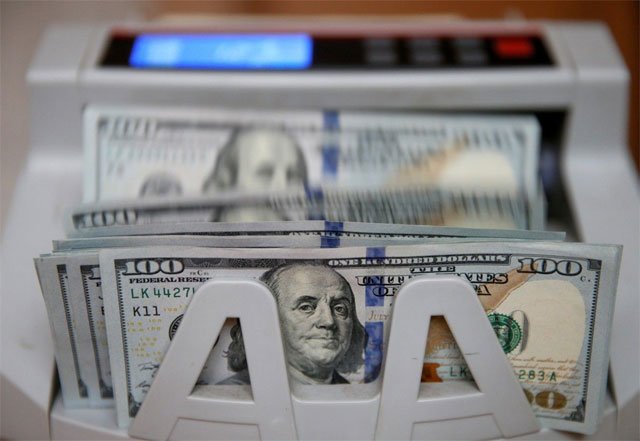
Unlike the past when the government pursued road shows to lure investors, an exercise that consumes more time, this time the finance ministry has decided to explore the tap off option, said sources in the ministry. The option will be deemed as an extension of the last bond issue and save time for a desperate finance ministry.
In the tap off option, the ministry would not require hiring financial advisers afresh and it will build on the offers that Pakistan received in November 2017 when it raised $2.5 billion. The government will issue the 10-year dollar denominated Eurobonds, they added.
Pakistan borrows $2.5b from global capital markets
Although the finance ministry wants to complete the exercise next week, it has yet to secure the approval of the federal government to issue tax waivers for the transactions, the sources said. The exact issuance size will be determined on the basis of market appetite and pricing but the ministry is keen to raise at least $1 billion, said the sources. The ministry is also exploring the options to take more commercial loans.
Pakistan will test the international markets days after Fitch - one of the top three global credit rating agencies - downgraded the country’s outlook from stable to negative. According to Fitch’s analysis, Pakistan has been unable to sustain the gains made under the three-year International Monetary Fund (IMF) Extended Fund Facility, which ended in September 2016. The credit rating agency cited a fall in foreign exchange reserves coupled with a widening fiscal deficit as a major indicator of reversals made after the IMF’s programme ended in September 2016.
A consortium comprising Standard Chartered Bank, Industrial and Commercial Bank of China, Citibank, Deutsche Bank, Dubai Islamic Bank and Noor Bank that handled the November 2017 issue will again be the Joint Lead Manager for the fresh issue.
In November, Pakistan raised $2.5 billion from global capital markets through a five-year Sukuk and 10-year Eurobond in the largest transaction at close to one of the lowest rates. Pakistan got around $8 billion offers for both the Sukuk and Eurobond, allowing the country to get the best deal.
The government raised $1 billion through Sukuk at 5.625% and the rest of the $1.5 billion were generated through 10-year bonds at 6.875 %, which was 455 basis points above the corresponding 10-year US Treasury benchmark rate.
Before borrowing $2.5 billion, Pakistan’s official foreign currency reserves had dipped to $13.6 billion. The country has consumed the entire $2.5 billion sum in just two months. The SBP on Thursday disclosed that during the week ending 26 January the SBP’s reserves decreased by $299 million to $13.234 billion - lower than what Pakistan had before floating the last bonds.
The reserves are inclusive of $6.2 billion that the central bank has temporarily borrowed from the domestic commercial banks.
In order to meet its foreign currency requirements, the PML-N government has so far raised a whopping $13.8 billion by floating bonds and taking commercial loans during the past four and a half years. These include $6.8 billion in expensive foreign commercial loans and $7 billion Sukuk and Eurobond notes.
In its first four and half years, the PML-N government took gross $40 billion foreign loans to build official foreign currency reserves, finance the external account and return the previously obtained loans.
In its Debt Policy Statement 2017-18, which the finance ministry submitted to the lower house of parliament, the government admitted that during the last fiscal year the country’s external debt increased at a rapid pace than its foreign exchange earnings. It was a higher ratio than the recorded in the last year of the PPP government.
Cabinet allows $3b borrowing through Sukuk, Eurobonds
Not only that, Pakistan’s external debt in percentage of foreign exchange reserves also increased to a three-year high. Similarly, the cost of external debt servicing in percentage of foreign exchange earnings significantly increased - also higher than the last year of the PPP.
The PML-N government is reluctant to go back to the IMF due to upcoming general elections, although the external account conditions suggest that it will be difficult to manage without the global lender for a longer time.
Published in The Express Tribune, February 2nd, 2018.
Like Business on Facebook, follow @TribuneBiz on Twitter to stay informed and join in the conversation.
1719660634-1/BeFunky-collage-nicole-(1)1719660634-1-405x300.webp)

1732276540-0/kim-(10)1732276540-0-165x106.webp)

1732274008-0/Ariana-Grande-and-Kristin-Chenoweth-(1)1732274008-0-165x106.webp)
1724249382-0/Untitled-(640-x-480-px)1724249382-0-270x192.webp)


1732270499-0/Express-Tribune-(7)1732270499-0-270x192.webp)
1732267715-0/BeFunk_§_]__-(32)1732267715-0.jpg)







COMMENTS (5)
Comments are moderated and generally will be posted if they are on-topic and not abusive.
For more information, please see our Comments FAQ